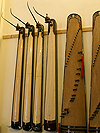|
dan bau (đàn bầu)
Vietnamese. ‘Gourd string
instrument’. An acoustical instrument,
consisting of a trapezoidal sound box with a single string stretched
lengthwise along the body of the soundboard and a movable bridge with a
wooden handle or tremolo bar with half of a dried gourd, attached to one
end of the sound box, opposite of the tuning peg. The gourd covers the
handle at the very point where the string is attached and contributes to
the amplification of the sound volume of the instrument. Originally, its
was made up from the top half of a
bottle gourd,
though nowadays, the gourd is usually replaced with a more durable
turned, wooden, bell-shaped cup. In Vietnamese the word bau (bầu) means
‘gourd’,
hence the instrument's name. The soundboard is made from
bamboo or softwood usually with hardwood flanks, whilst the
handle is made of wood, and the string and tuning peg of steel,
though in the past a silk string was used
and the tuning peg was formerly made of
bamboo or wood. The dan bau is usually tuned to the note C and is played
by plucking the string, whilst touching it lightly with the side
of the hand. By moving the tremolo
bar, the tension of the string can be varied, causing the pitch to rise
or fall. In the same way, a note may be lengthened or shortened and subtle glissandi sounds can be produced by plucking the
string, whilst pulling the whammy bar. It is sometimes used to study
musical tones. Also called dan doc huyen (đàn độc huyền) and doc huyen
cam (độc huyền cầm), and in English referred to as monochord, a word
derived from the Greek word monochordos (μονόχορδος), meaning
‘one string’. The dan bau is quite similar
to the du xian qin (独弦琴), found in southern
China,
yet it is of purely Vietnamese origin.
回






|

